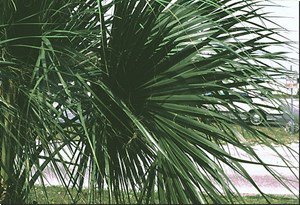Palm trees have quite a fascinating history. For centuries, these tropical plants have been used to create shelter, source food and even make furniture.
If you’re curious about the backstory of a palm tree in your yard, first you need to find out what tree you have! With over 2,600 species in the palm tree family, it takes a little digging to pinpoint your tree type.
Read on to learn how to identify palm trees and what care they need to grow their best.
Different types of palm trees
There are thousands of palm trees around the world; and even though only a handful are native to the U.S., many non-native palms grow and thrive in our yards. Let’s talk about how to whittle down the list and find out your palm tree type!
What kind of palm tree do I have?
To identify your palm, start by looking closely at its leaves (which are called “fronds”) and its trunk.
Palm tree identification by leaf
Palm tree fronds come in three shapes: palmate, pinnate, and costapalmate.
- Palmate palms have fronds that resemble a fan. A few palms that fall into this category are windmill, Mexican fan, and California fan palm.

- Pinnate palm fronds are separate from each other but still attached to one main stem. A few palms that have this feather-like shape are coconut, queen, and date palms.

- Costapalmate palms are a cross between palmate and pinnate. The Chinese fan palm and cabbage palm fall into this group.

Palm Tree Identification by Trunk
Just like their fronds, palm tree trunks come in threes.
- A few palms with a single, tall and slender trunk are the foxtail, queen, and cabbage palm.
- Palms with short and fat trunks include majesty, bottle, and pindo palm.
- A few palms with a group of three or four short trunks growing together are Senegal date palm and Paurotis palm.
How to take care of palm trees
- Grow zones: Palms grow best in zones 9-11. In these areas, summers are hot and humid, and winters are mild with little chance of cold weather. That said, there are some hardy palms (like European fan and pindo palm) that can handle the slightly colder temps in planting zones 7 or 8. Windmill palms can also grow in the Seattle area.
- Where to plant: Palm trees can adapt to different soil types, but their preference is loose, sandy soil that drains well.
- Height/Spread: With so many species of palms to grow, there’s no standard height to expect. Dwarf palms can max out at just four or five feet tall, which other palms can grow to 30, 40 or 50-plus feet tall.
- Sunlight: Many palms require six hours or more of direct sunlight every day. But some palms, like needle palm or lady palm, grow better in shade.
- Pruning: Every now and then, palm trees need a touch up to get rid of brown fronds. Check out this 3-step guide on how to prune a palm tree for help.
- How to water palm trees: Palms like their soil to stay moist, but not saturated. Never let the tree’s soil dry out between waterings, but hold off on water if the soil is soggy.
Potential Threats
A few pests and diseases can leave palm trees with a not-so-pretty appearance.
- Brown and droopy palm fronds might come with an easy fix, for example, watering your tree more or adding nutrients to the soil. But first, you’ll want to rule out a potential pest or disease. Find out why your palm tree fronds are turning brown.
- Yellow palm tree fronds sometimes indicate a small, manageable problem as well. But things can get complicated if you’re dealing with a pest or a palm tree fungus called Ganoderma root. Read more about why palm tree leaves turn yellow.






